Attached files
| file | filename |
|---|---|
| 8-K - 8-K - Ardea Biosciences, Inc./DE | a54060e8vk.htm |
| EX-99.2 - EX-99.2 - Ardea Biosciences, Inc./DE | a54060exv99w2.htm |
Exhibit 99.1

| Company Update October 19, 2009 |
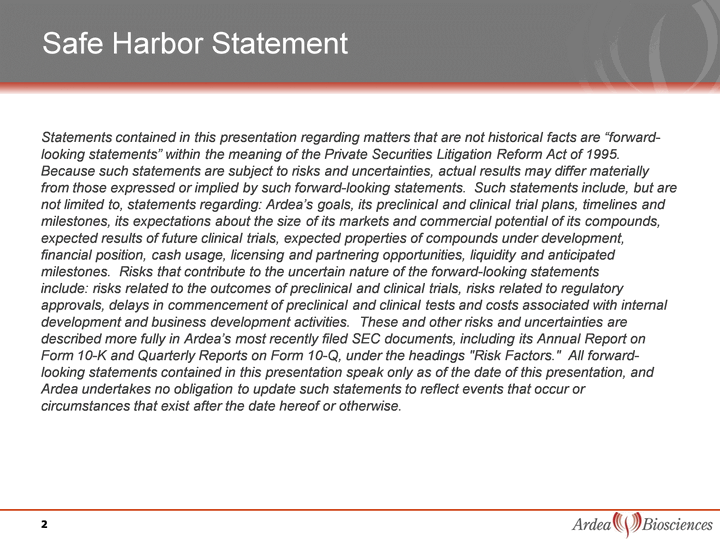
| Safe Harbor Statement Statements contained in this presentation regarding matters that are not historical facts are "forward- looking statements" within the meaning of the Private Securities Litigation Reform Act of 1995. Because such statements are subject to risks and uncertainties, actual results may differ materially from those expressed or implied by such forward-looking statements. Such statements include, but are not limited to, statements regarding: Ardea's goals, its preclinical and clinical trial plans, timelines and milestones, its expectations about the size of its markets and commercial potential of its compounds, expected results of future clinical trials, expected properties of compounds under development, financial position, cash usage, licensing and partnering opportunities, liquidity and anticipated milestones. Risks that contribute to the uncertain nature of the forward-looking statements include: risks related to the outcomes of preclinical and clinical trials, risks related to regulatory approvals, delays in commencement of preclinical and clinical tests and costs associated with internal development and business development activities. These and other risks and uncertainties are described more fully in Ardea's most recently filed SEC documents, including its Annual Report on Form 10-K and Quarterly Reports on Form 10-Q, under the headings "Risk Factors." All forward- looking statements contained in this presentation speak only as of the date of this presentation, and Ardea undertakes no obligation to update such statements to reflect events that occur or circumstances that exist after the date hereof or otherwise. 2 |

| Status of Development Programs RDEA427 RDEA806 RDEA119 RDEA119/ RDEA436 Discovery Preclinical Phase 0/1 Phase 2 A B Phase 3 NNRTI for HIV NNRTI for HIV MEKI for cancer Inflammation 3 Gout RDEA594 RDEA684 MEKI + sorafenib for cancer RDEA119 Gout Partnered with Bayer |
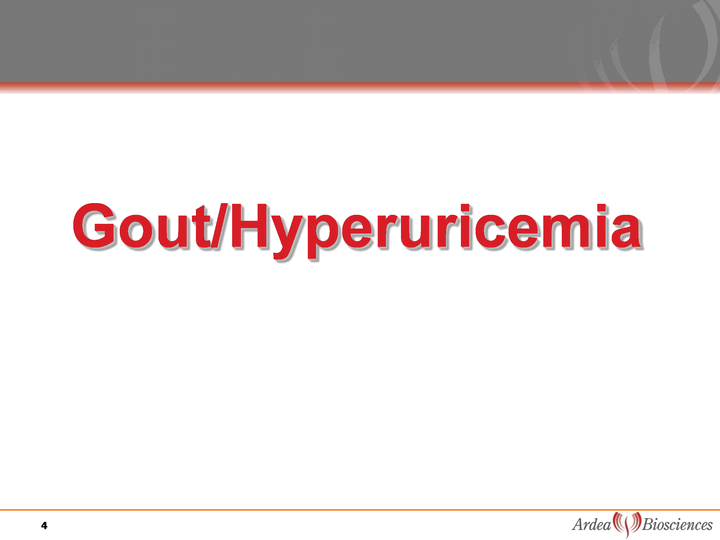
| Gout/Hyperuricemia 4 |

| Hyperuricemia/Gout - Unmet Medical Need Gout is caused by abnormally elevated levels of uric acid (>6.8 mg/dL) Painful and debilitating disease Attacks of severe pain/Inflammation Disfiguring nodules (tophi) Kidney damage (nephropathy) Increasing incidence and severity in U.S. (> 5,000,000 potential patients) 288% increase in gout related hospitalizations from 1988-20051 $11.2 billion hospitalization cost in 20051 Only one new drug available for hyperuricemia in last 40 years Hyperuricemia linked to elevated C-Reactive Protein, hypertension, increased mortality in Chronic Kidney Disease4 and possibly other cardiovascular risk factors2 ~90% of patients are "under-excretors" of uric acid Defect in urate transporter recently found to be genetically linked to gout3 1Ann Rheum Dis 2008;67(Suppl II):96; 2 JAMA. 2008;300(8):924-932 3Nature Genetics 40, 437 - 442 (2008) 4Am J Kidney Dis 2009;53:796-803 5 |

| Hare, J. M. et al. Circulation 2003;107:1951-1953 Uric Acid Production and Elimination Allopurinol Febuxostat RDEA594 Probenecid Benzbromarone* 6 *Benzbromarone is a URAT1 inhibitor approved outside of the US and later withdrawn due to liver toxicity. Pegloticase |
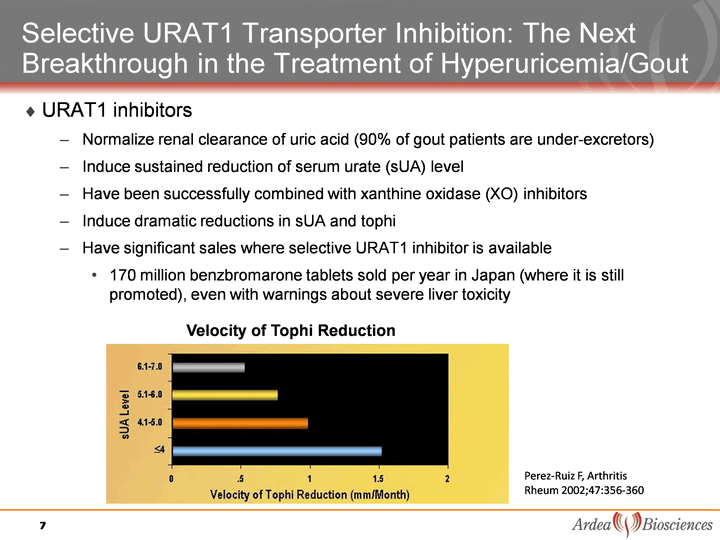
| 7 Selective URAT1 Transporter Inhibition: The Next Breakthrough in the Treatment of Hyperuricemia/Gout URAT1 inhibitors Normalize renal clearance of uric acid (90% of gout patients are under-excretors) Induce sustained reduction of serum urate (sUA) level Have been successfully combined with xanthine oxidase (XO) inhibitors Induce dramatic reductions in sUA and tophi Have significant sales where selective URAT1 inhibitor is available 170 million benzbromarone tablets sold per year in Japan (where it is still promoted), even with warnings about severe liver toxicity Perez-Ruiz F, Arthritis Rheum 2002;47:356-360 Velocity of Tophi Reduction |

| Important Commercial Opportunities for URAT1 Inhibitor Monotherapy inadequate responders to allopurinol patients who are intolerant to allopurinol first-line treatment (not primary target) Combination with allopurinol 60% of allopurinol patients don't achieve adequate reduction in uric acid Potential for fixed combination to move into first-line Patients with renal impairment Dose reduction of allopurinol reduces efficacy in this group Treatment failure gout patients, either before, during or after pegloticase 8 |

| Uric Acid-Lowering Was Noticed With RDEA806 Up to 45% reductions in serum urate (sUA) were observed in healthy volunteers in the 10-day multiple ascending dose study Uric acid reductions of were also observed in all HIV patients in the Phase 2a monotherapy study with RDEA806 A 28-day proof-of-concept study with RDEA806 in gout patients confirmed its activity and tolerability in the target patient population with sUA reductions averaging 36%, with individual reductions up to 60% Over 250 subjects have received RDEA806 (and exposed to RDEA594) with: No SAEs, deaths or discontinuations due to adverse events No clinically significant changes in physical exam findings or vital signs No clinically significant changes in laboratory parameters except sUA (no evidence of renal toxicity) 9 |

| RDEA594 Preclinical and Phase 1 Summary RDEA594 is a selective inhibitor of the URAT1 renal transporter (EC50 = 5-10 ^M) without antiviral activity No effect on OAT1 and OAT3 transporters (no interaction with antivirals or other drugs secreted by these transporters) Limited metabolism by CYP450 Inhibitors or inducers will not effect RDEA594 metabolism No mitochondrial toxicity (possible cause of benzbromarone toxicity) No significant organ toxicity seen in a 3-month and 6-month assessment of chronic toxicity of RDEA594 in rats and monkeys, respectively, at doses up to 300 mg/kg/day RDEA594 has dose-linear pharmacokinetics and sUA reductions in normal healthy volunteers No significant toxicity in ~100 subjects in Phase 1 Composition of matter and use patents filed in 2008 10 |
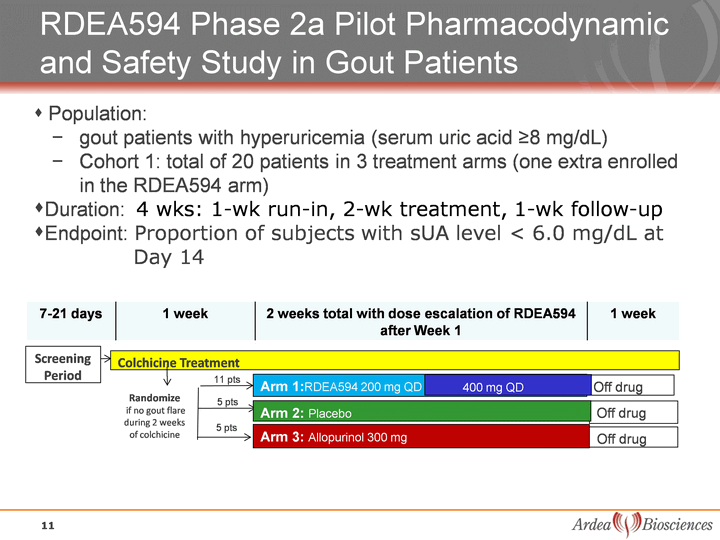
| Arm 1:RDEA594 200 mg QD Screening Period Colchicine Treatment Randomize if no gout flare during 2 weeks of colchicine Off drug Off drug Arm 2: Placebo 400 mg QD Off drug Arm 3: Allopurinol 300 mg 5 pts 5 pts 11 pts 7-21 days 1 week 2 weeks total with dose escalation of RDEA594 after Week 1 1 week Population: gout patients with hyperuricemia (serum uric acid ^8 mg/dL) Cohort 1: total of 20 patients in 3 treatment arms (one extra enrolled in the RDEA594 arm) Duration: 4 wks: 1-wk run-in, 2-wk treatment, 1-wk follow-up Endpoint: Proportion of subjects with sUA level < 6.0 mg/dL at Day 14 RDEA594 Phase 2a Pilot Pharmacodynamic and Safety Study in Gout Patients 11 |

| Baseline Demographics Baseline Demographics 12 |
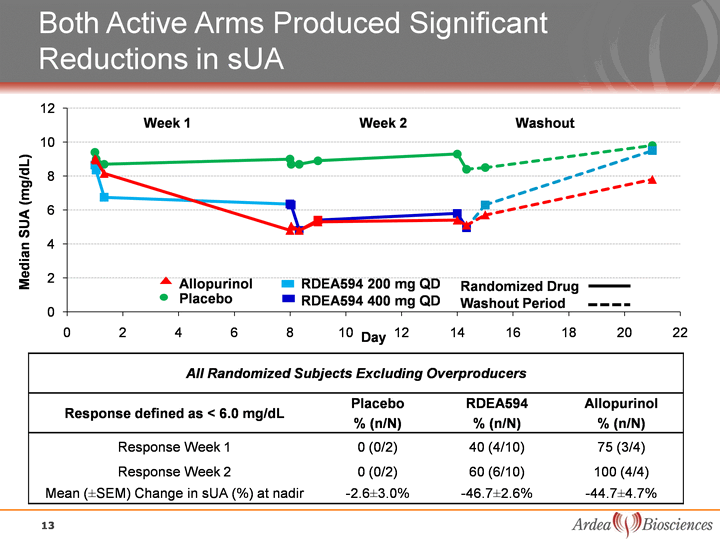
| (CHART) Randomized Drug Washout Period All Randomized Subjects Excluding Overproducers All Randomized Subjects Excluding Overproducers All Randomized Subjects Excluding Overproducers All Randomized Subjects Excluding Overproducers Response defined as < 6.0 mg/dL Placebo % (n/N) RDEA594 % (n/N) Allopurinol % (n/N) Response Week 1 0 (0/2) 40 (4/10) 75 (3/4) Response Week 2 0 (0/2) 60 (6/10) 100 (4/4) Mean (+-SEM) Change in sUA (%) at nadir -2.6+-3.0% -46.7+-2.6% -44.7+-4.7% Both Active Arms Produced Significant Reductions in sUA 13 |
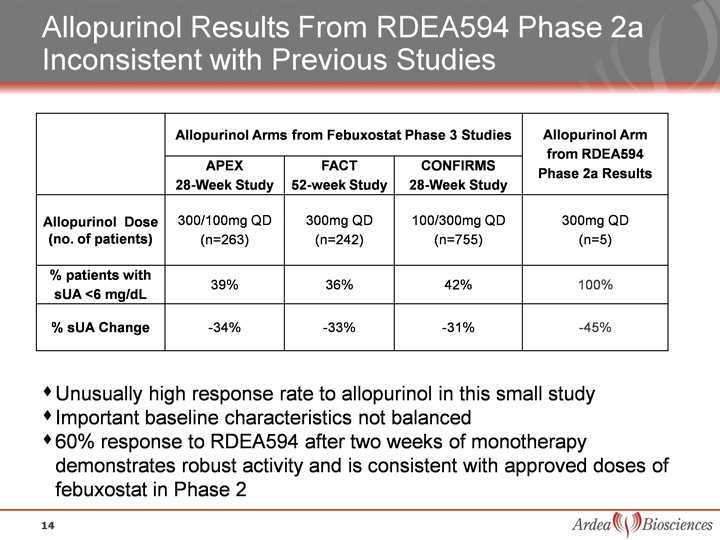
| Allopurinol Results From RDEA594 Phase 2a Inconsistent with Previous Studies 14 Febuxostat Phase 3 Study Results Febuxostat Phase 3 Study Results Febuxostat Phase 3 Study Results RDEA594 Phase 2a Results APEX 28-Week Study FACT 52-week Study CONFIRMS 28-Week Study RDEA594 Phase 2a Results Allopurinol Dose (no. of patients) 300/100mg QD (n=263) 300mg QD (n=242) 100/300mg QD (n=755) 300mg QD (n=5) % patients with sUA <6 mg/dL 39% 36% 42% 100% % sUA Change -34% -33% -31% -45% Unusually high response rate to allopurinol in this small study Important baseline characteristics not balanced 60% response to RDEA594 after two weeks of monotherapy demonstrates robust activity and is consistent with approved doses of febuxostat in Phase 2 |

| (CHART) 83% Response in Renally Impaired Patients Observed with RDEA594 All Subjects with Mild to Moderate Renal Insufficiency (Cockcroft-Gault) All Subjects with Mild to Moderate Renal Insufficiency (Cockcroft-Gault) All Subjects with Mild to Moderate Renal Insufficiency (Cockcroft-Gault) All Subjects with Mild to Moderate Renal Insufficiency (Cockcroft-Gault) Response defined as < 6.0 mg/dL Placebo % (n/N) RDEA594 % (n/N) Allopurinol % (n/N) Response Week 1 0 (0/0) 50 (3/6) 100 (1/1) Response Week 2 0 (0/0) 83 (5/6) 100 (1/1) Mean (+-SEM) Change in sUA (%) at nadir - -47.8+-4.2% -56.1 15 |
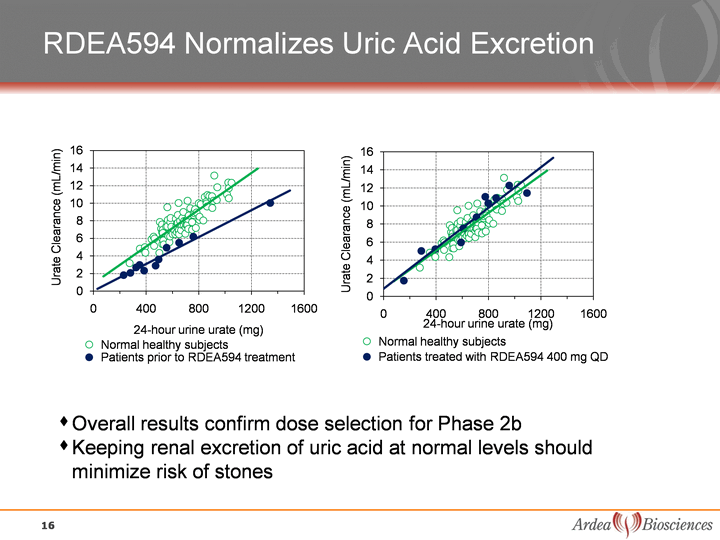
| (CHART) (CHART) RDEA594 Normalizes Uric Acid Excretion Overall results confirm dose selection for Phase 2b Keeping renal excretion of uric acid at normal levels should minimize risk of stones 16 |

| Treatment Group Mild Moderate Severe Serious Adverse Event Treatment Group (grade 1) (grade 2) (grade 3) Serious Adverse Event Treatment Group N Number of Adverse Events (Number of patients, n/N) Number of Adverse Events (Number of patients, n/N) Number of Adverse Events (Number of patients, n/N) Number of Adverse Events (Number of patients, n/N) RDEA594 11 11 (6/11) 1 (1/11)* 0 0 Placebo 5 3 (2/5) 1 (1/5) 0 0 Allopurinol 5 3 (2/5) 4 (3/5) 1** (1/5) 1** (1/5) * Grade 2 prostatitis not considered related to RDEA594 **Acute coronary syndrome was both severe and a serious adverse event due to hospitalization * Grade 2 prostatitis not considered related to RDEA594 **Acute coronary syndrome was both severe and a serious adverse event due to hospitalization * Grade 2 prostatitis not considered related to RDEA594 **Acute coronary syndrome was both severe and a serious adverse event due to hospitalization * Grade 2 prostatitis not considered related to RDEA594 **Acute coronary syndrome was both severe and a serious adverse event due to hospitalization * Grade 2 prostatitis not considered related to RDEA594 **Acute coronary syndrome was both severe and a serious adverse event due to hospitalization * Grade 2 prostatitis not considered related to RDEA594 **Acute coronary syndrome was both severe and a serious adverse event due to hospitalization Treatment Group N Mild Moderate Severe Treatment Group N (grade 1) (grade 2) (grade 3/4) Treatment Group N Laboratory abnormality with increase in CTC grade Laboratory abnormality with increase in CTC grade Laboratory abnormality with increase in CTC grade RDEA594 11 AST Creatinine (2) - Placebo 5 - Glucose, ALT, Triglycerides - Allopurinol 5 ALT - Aldosterone Only Mild to Moderate Adverse Events and Grade 1 Laboratory Abnormalities with RDEA594 Severity Grade of Adverse Events Severity Grade of Laboratory Abnormalities No significant toxicities on RDEA594 Remarkably few events in almost 400 people exposed to RDEA594 Safety profile supports positive Phase 2b outcome 17 |

| Arm 1:RDEA594 200 mg QD Screening Period Colchicine Treatment Randomize if no gout flare during 2 weeks of colchicine Off drug Off drug Arm 2: Placebo 400 mg QD Off drug Arm 3: Allopurinol 300 mg 5 pts 5 pts 11 pts 7-21 days 1 week 2 weeks total with dose escalation of RDEA594 after Week 1 1 week Population: gout patients with hyperuricemia (serum uric acid ^ 9 mg/dL) Cohort 2: total of 6 patients: 5 on RDEA594 + 1 placebo Duration: 4 wks: 1-wk run-in, 2-wk treatment, 1-wk follow-up Endpoint: Proportion of subjects with sUA level < 6.0 mg/dL at Day 14 RDEA594 Phase 2a Pilot Pharmacodynamic and Safety Study in Gout Patients - Cohort 2 Enrolling Allopurinol 300 mg Allo+ RDEA594 400 mg QD Allo+ RDEA594 200 mg QD Off drug Cohort 2: 21 pts 18 Allopurinol 300 mg Off drug Allopurinol + Placebo Cohort 1: 6 pts |

| RDEA594 Phase 2b Monotherapy Dose- Response, Safety and Efficacy Study - Enrolling 21 days 2 weeks 4 weeks 2 weeks Population: gout patients with hyperuricemia (serum uric acid ^8 mg/dL) total of 140 patients in 4 treatment arms Duration: 8 wks: 2-wk run-in, 4-wk treatment, 2-wk follow-up: dose will be titrated up weekly to reduce possible gout flares and nephrolithiasis Endpoints: proportion of subjects with sUA level < 6.0 mg/dL at Day 28 safety and tolerability of the combination versus placebo Arm 1: RDEA594 200 mg - 35 pts Screening Period Washout of urate lowering therapy Colchicine Treatment Randomize if no gout flare during 2 weeks of colchicine Off drug Arm 2: RDEA594 400 mg - 35 pts Off drug Arm 4: RDEA594 Placebo - 35 pts Off drug Arm 3: RDEA594 600 mg - 35 pts Off drug 19 |

| RDEA594 Phase 2b Allopurinol Add-On Combination Safety and Efficacy Study - Enrolling Dose Escalation Based on sUA Lowering with 200 mg RDEA594: 18 patients initially, including 12 patients randomized to RDEA594 and 6 patients randomized to placebo 20 RDEA594 100 mg and 300 mg or placebo plus allopurinol 300 mg RDEA594 200 mg or placebo plus allopurinol 300 mg RDEA594 300 mg and 400 mg or placebo plus allopurinol 300 mg or Dose Escalation/Reduction Cohorts: 36 patients per dose, including 24 patients randomized to RDEA594 and 12 patients randomized to placebo per cohort Dose Reduction Cohorts: if >75% of patients have sUA < 5 mg/dL, then go to100 mg QD and 300 mg QD, and full 36 patients on 200 mg QD Dose Escalation Cohorts: if <75% meet criteria, then go to 300 mg and 400 mg QD Study Design - all cohorts: Double-blind, randomized, placebo-controlled Dose will be titrated up weekly to reduce possible gout flares and nephrolithiasis Same design as Phase 2 dose response study, with colchicine given for gout flare prophylaxis |
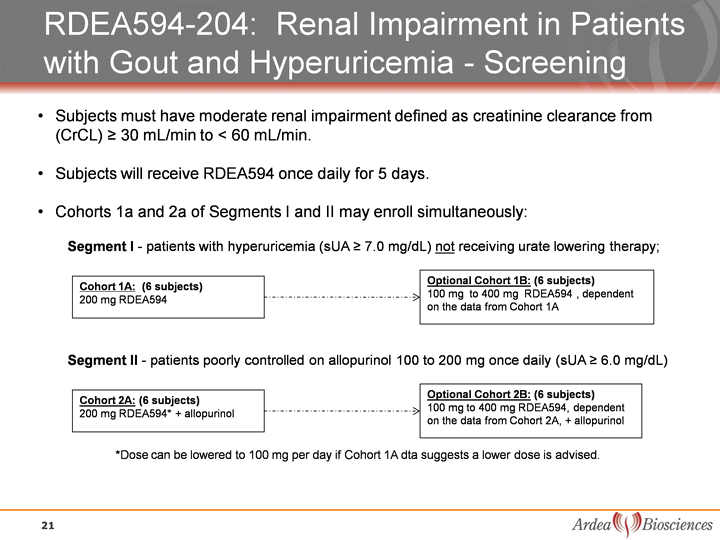
| RDEA594-204: Renal Impairment in Patients with Gout and Hyperuricemia - Screening Cohort 1A: (6 subjects) 200 mg RDEA594 Subjects must have moderate renal impairment defined as creatinine clearance from (CrCL) ^ 30 mL/min to < 60 mL/min. Subjects will receive RDEA594 once daily for 5 days. Cohorts 1a and 2a of Segments I and II may enroll simultaneously: Segment I - patients with hyperuricemia (sUA ^ 7.0 mg/dL) not receiving urate lowering therapy; Optional Cohort 1B: (6 subjects) 100 mg to 400 mg RDEA594 , dependent on the data from Cohort 1A Cohort 2A: (6 subjects) 200 mg RDEA594* + allopurinol Segment II - patients poorly controlled on allopurinol 100 to 200 mg once daily (sUA ^ 6.0 mg/dL) Optional Cohort 2B: (6 subjects) 100 mg to 400 mg RDEA594, dependent on the data from Cohort 2A, + allopurinol *Dose can be lowered to 100 mg per day if Cohort 1A dta suggests a lower dose is advised. 21 |
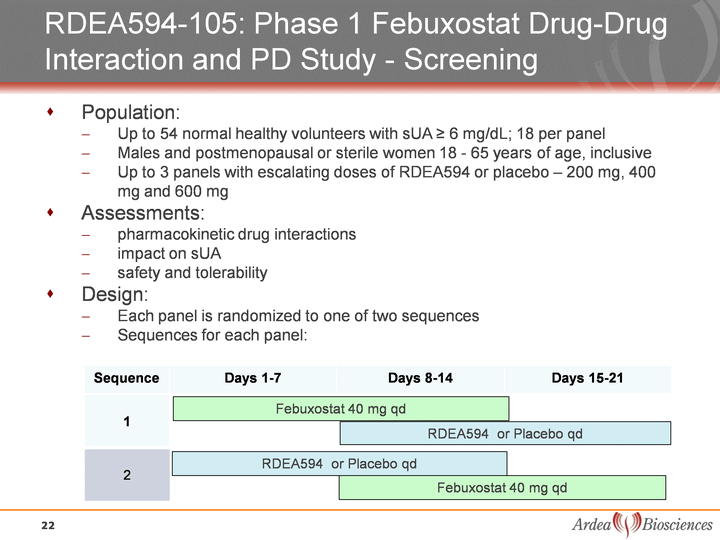
| RDEA594-105: Phase 1 Febuxostat Drug-Drug Interaction and PD Study - Screening Population: Up to 54 normal healthy volunteers with sUA ^ 6 mg/dL; 18 per panel Males and postmenopausal or sterile women 18 - 65 years of age, inclusive Up to 3 panels with escalating doses of RDEA594 or placebo - 200 mg, 400 mg and 600 mg Assessments: pharmacokinetic drug interactions impact on sUA safety and tolerability Design: Each panel is randomized to one of two sequences Sequences for each panel: Febuxostat 40 mg qd RDEA594 or Placebo qd Sequence Days 1-7 Days 8-14 Days 15-21 RDEA594 or Placebo qd Febuxostat 40 mg qd 1 2 22 |

| 23 There is a large unmet need for new treatments for this debilitating disease RDEA594, a selective URAT1 transport inhibitor, targets the physiologic cause of the vast majority of patients with hyperuricemia: uric acid under- excretion Clinical proof-of-concept has been achieved, with statistically and clinically significant reductions in uric acid in both healthy volunteers and in patients with hyperuricemia and gout Phase 2a supports dose selection for Phase 2b RDEA594 has been well tolerated in over 100 subjects at doses up to 600 mg and more than 250 subjects dosed with its prodrug, RDEA806 Safety profile supports positive Phase 2b outcome Phase 2 development program for RDEA594 is designed to demonstrate its broad clinical utility and to provide multiple Phase 3 options for further development Gout/Hyperuricemia Program Summary |
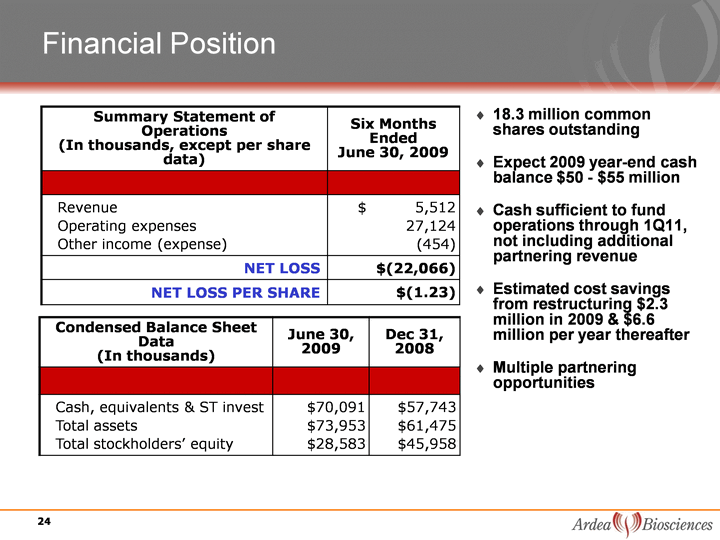
| Financial Position Summary Statement of Operations (In thousands, except per share data) Six Months Ended June 30, 2009 Revenue Operating expenses Other income (expense) $ 5,512 27,124 (454) NET LOSS $(22,066) NET LOSS PER SHARE $(1.23) 18.3 million common shares outstanding Expect 2009 year-end cash balance $50 - $55 million Cash sufficient to fund operations through 1Q11, not including additional partnering revenue Estimated cost savings from restructuring $2.3 million in 2009 & $6.6 million per year thereafter Multiple partnering opportunities Condensed Balance Sheet Data (In thousands) June 30, 2009 Dec 31, 2008 Cash, equivalents & ST invest Total assets Total stockholders' equity $70,091 $73,953 $28,583 $57,743 $61,475 $45,958 24 |

| Near-Term Anticipated Milestones Near-Term Anticipated Milestones 25 |
